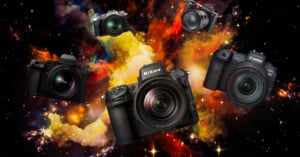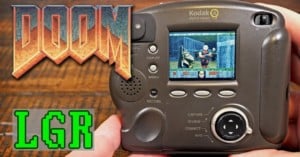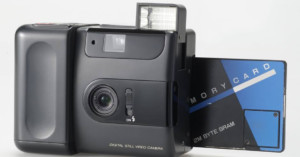
Gen Z Complain About The Difficulties of Using Digital Cameras
Generation Z users on TikTok are complaining about the difficulties of using a digital camera -- instead of a smartphone -- for taking photos.

Generation Z users on TikTok are complaining about the difficulties of using a digital camera -- instead of a smartphone -- for taking photos.

Canon's grip on camera sales dominance continues as a new report shows Canon has nearly half of the camera market share all to itself and nearly double the share Sony commands.

Camp Snap is a new screen-free digital camera designed to help children "live in the moment" while still creating digital memories.

The CameraFrame is a handcrafted piece of home decor that blends camera components into a hangable piece of wall art for photographers.

A tech start-up has developed a "non-disposable digital disposable camera" to bring some of the romance of film photography to the modern world.

Cameras all have a pretty solid set of features and design elements that appeal to a wide range of users. But, for the most part, pretty much all of them lack a set of features that would make them all a lot more powerful and enjoyable to use.

A photographer discovered beautiful street photos of Japan on a used $25 digital camera that she bought in New York City.

Released nearly three decades ago in 1994, the QuickTake 100 was Apple's first digital camera and among the very first digital cameras available to general consumers. But as much of an impact as it had back then, it hasn't aged well.

First, Generation Z was bringing back the point-and-shoot digital cameras of the early 2000s, but now TikTok users are bringing back the Fujifilm X100 -- and dramatically driving up the price of the camera with it.

There is a new camera trend that has taken off among Generation Z users on social media. Featuring grainy images and timestamps, the point-and-shoot digital cameras of the early 2000s are making a comeback.

Steve Sasson is an electrical engineer who invented the digital camera while working for Kodak. The Rochester, New York, company, which had made its fortune by selling photographic film and paper for most of the 20th century, did not think that Sasson's digital camera had any place in photography, and that lack of foresight ironically put Kodak out of business.

Getting a new digital camera is an exciting time for photographers and videographers. A world of possibilities and learning lies ahead as well as doors to new adventures and places to visit. But it’s not always smooth sailing when it comes to using a new camera as a beginner. There are lots of complex numbers, letters, and acronyms to wrap your head around, let alone figuring out how to operate the numerous dials, buttons, and switches. But by following the simple steps included in this checklist you should be up and running in no time.

Inspired by do-it-yourself camera parts and projects, Ping-Hsun Chen and Ruha Cheng took things a step further and released a retro-style RUHAcam kit built around a Raspberry Pi Zero W connected to the High-Quality Camera Module.

The Valoi 360 is a system of modular tools that aims to make it much easier and cheaper to digitize 35mm or 120 film negatives using a digital camera. It's made to be faster and more effective than a flatbed scanner.

Why does someone build their own camera? Maybe for technical reasons, usability enhancements, or perhaps personal style and artistic outlook. The raison d'ètre for the experimental camera I made here falls somewhere between all of the above.

Almost two years ago, the French startup PIXII announced the development of a "radical" M-mount digital rangefinder that had neither a rear display nor any sort of memory card slot. Now, this strange camera is finally available for brave early-adopters to order... if you're willing to drop 3 grand, that is.

It was early 2000, and the world looked on towards a new and exciting millennium, thankful that their worst fears surrounding Y2K never surfaced. At the time, I was getting ready to launch my portrait photography business using a completely digital capture and workflow, and was intent on investing in the Nikon D1 as my primary camera.

Popular retro tech YouTube channel LGR recently pulled off something pretty awesome, if totally ridiculous. The channel's host Clint Basinger managed to install a working copy of the original video game Doom onto a Kodak digital camera from 1998. Really gives new meaning to the term "point and shoot" camera, doesn't it?

There are plenty of new digital camera unboxing videos these days, but they're generally not like this one. Lazy Game Reviews got its hands on an Epson PhotoPC and created this 11-minute video showing what it was like to unbox and use a digital camera back in 1995.

It seems that a lot of photography enthusiasts want to shoot a stripped down digital camera with pretend film rolls. The Kickstarter campaign for Yashica's new Y35 "DigiFilm" camera is now over, and it managed to raise a staggering HK$10,035,296 (~$1,284,559) from 6,935 supporters to bring the camera to market.

If you need a simple, straight-forward explanation of how the digital camera captures photos, look no further. This creative little animation by YouTube channel Some Stuff Explained does a fantastic job.

The Leica M-D (the digital rangefinder with no LCD screen)—all hype, or the real deal?

Polaroid hasn't given up on instant photography yet. Following up on the release of the Polaroid Snap last year, the Polaroid Snap Touch "instant digital" camera combines the features of both a digital and instant camera into a fun, affordable package.

It's easy to forgot how easy we have it shooting digital in 2016, because when digital cameras first started picking up steam they were not easy to use. How difficult were they? Watch as Jared Polin of Fro Knows Photo takes the 15-year-old Nikon D1X out for a modern day on-location portrait shoot.

Ask a photo nerd and they'll tell you that the world's first digital camera was invented in the 70s by Steve Sasson while working at Kodak (oh, the irony). But did you know that it's Fuji, not Kodak, who claims they invented the world's first "fully" or "truly" digital camera? It's true.

Here's a fun little piece of photography trivia: did you know that when it was released in 1998, the Game Boy Camera was the world's smallest digital camera?

If you were into photography in the early days of digital cameras, you probably remember the "revolutionary" Sony Mavica line, which used 3.5-inch floppy disks as 1.44MB "memory cards".

It's #throwbackthursday, right? Good, because we have a rather interesting piece of photography history to share with you, courtesy of NASA, Nikon and Kodak.

Building your own touchscreen, WiFi-enabled digital camera might seem like the most expensive of photo-related DIY projects, but it doesn't have to be. In fact, Adafruit can show you how to put one together for less than $150!

If flashlights can be solar and mechanically powered, why can't digital cameras? Turns out they can. Superheadz Japan has launched a new digital camera called the "Sun & Cloud." It's the world's first digital camera that's capable of generating its own power so that you don't need to constantly be worrying about battery drain and recharging.

Most high-end digital cameras (not named Ricoh) aren't designed to be modular. If you want a new sensor in your camera, you'll need to buy an entirely new camera. Want to use a different lens system? You're out of luck.
What if there existed a universe in which all the major camera companies came together to form an extremely versatile modular digital camera? That's what Korean designers Dae jin Ahn and Chun hyun Park are attempting to answer with their concept camera design, called Equinox.

Hong Kong-based design group Carbon has created a novelty digital camera called the One Mini, which is designed to look just like a pocket-sized version of Polaroid's iconic SX-70 One Step instant camera.

Here's a dissection video for those of you who like photography better than biology. It's a Khan Academy lesson that offers a glimpse into how digital cameras work on the inside. The camera being dissected is a Vivitar V25, a 2.1 megapixel camera that you can pick up for around $18 from places like Walmart. Although it's basically the digital equivalent of a disposable camera, the camera still shares some things in common with higher-end digital cameras. You might be able to learn an interesting thing or two about how your own camera works.

What if there were a disposable digital camera that you could eat after using? Sounds bizarre, but it already exists. Scientists in the US are working on uber-thin electronics that can be dissolved inside the human body once their job is done. Among the many possible uses being explored is photography.

Did you know that LCD screens and live view didn’t arrive until a number of years after digital cameras …

Scientists at Duke University have created a digital camera that boasts a whopping 50 gigapixels. The camera, dubbed AWARE-2, uses 98 separate 14-megapixel microcameras and a special spherical lens. Each microcamera captures a tiny portion of the scene and a specially designed processor stitches the images together. Processing the data is so hardware intensive that 97% of the camera is made up of electronics and computer components (the other 3% is the optical elements).

Earlier this week a photograph of a mysterious IKEA digital camera crafted out of cardboard took the web by storm. Now more details are emerging and we now know that the camera is very much real. It will be called KNÄPPA, and was designed in collaboration with Stockholm’s Teenage Engineering. Billed as "the world's cheapest digital camera", the KNÄPPA is made out of a single piece of folded cardboard, a single circuit board, a camera sensor, and an integrated USB connector.

Check out this strange looking digital camera made by IKEA out of cardboard. It was included as part of …

If you’re in the market for a new digital camera this year, buying it in January or February might …

Expose two images without advancing your film, and you have yourself an in-camera double exposure photograph. With …